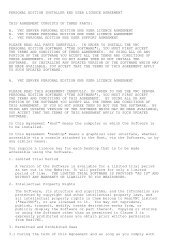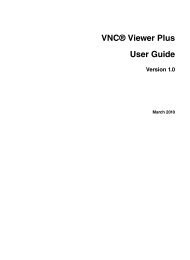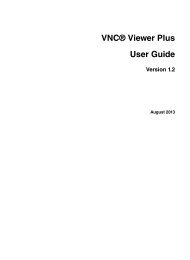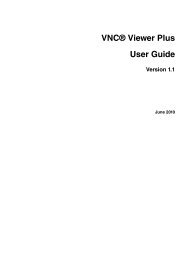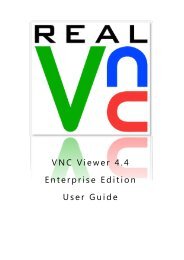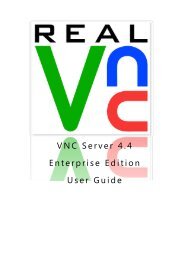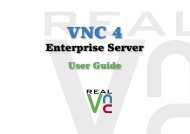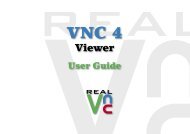VNC User Guide - RealVNC
VNC User Guide - RealVNC
VNC User Guide - RealVNC
Create successful ePaper yourself
Turn your PDF publications into a flip-book with our unique Google optimized e-Paper software.
Appendix A: Saving Connections<br />
For more information on editing <strong>VNC</strong> Viewer options, start with Configuring <strong>VNC</strong> Viewer before you connect<br />
on page 35.<br />
To rename a connection in <strong>VNC</strong> Address Book, select it in the Alphabetic or Hierarchical list and select<br />
Edit > Rename, or right-click and select Rename from the shortcut menu.<br />
Sharing connections<br />
You can share one or more connections with other fully-featured <strong>VNC</strong> Viewer users. Note that <strong>VNC</strong> Server<br />
passwords are also shared, albeit in obfuscated or encrypted form.<br />
To share:<br />
• All <strong>VNC</strong> Address Book connections, select Tools > Export Address Book.<br />
• A single connection, right-click it in the Alphabetic or Hierarchical list and, from the shortcut menu,<br />
select Export.<br />
Choose a location for the exported file. If the file contains a protected connection (one in which the <strong>VNC</strong><br />
Server password was saved and encrypted), the recipient will need your <strong>VNC</strong> Address Book master<br />
password in order to import it.<br />
You can import one or more connections shared by other fully-featured <strong>VNC</strong> Viewer users. To do this, select<br />
Tools > Import Address Book, and select the file to import. If the file contains a protected connection, you<br />
will need the <strong>VNC</strong> Address Book master password of the user who created the file in order to import it.<br />
Removing connections<br />
To remove a connection, select it in the Alphabetical or Hierarchical list, and either:<br />
• Click the Delete toolbar button.<br />
• Select Edit > Delete.<br />
Working with the master password<br />
If you chose to encrypt a <strong>VNC</strong> Server password when you saved a connection to a host computer, you<br />
created a protected connection.<br />
<strong>VNC</strong> Address Book secures protected connections using the master password. You must enter the master<br />
password in order to perform an operation on a protected connection, for example connecting to the host<br />
computer, or editing the connection.<br />
Note: You do not have to enter the master password in order to perform operations on connections for which<br />
the <strong>VNC</strong> Server password was not saved, or was saved in obfuscated, though not encrypted, form. For more<br />
information on saving <strong>VNC</strong> Server passwords, start with Saving the current connection on page 122.<br />
By default, <strong>VNC</strong> Address Book remembers the master password for one hour. This means you have sixty<br />
minutes after you first enter it in order to perform an operation on a protected connection. To change this,<br />
and require the entry of the master password, select:<br />
• Tools > Forget Master Password to require the entry of the master password for the next operation on<br />
a protected connection.<br />
130 <strong>VNC</strong> <strong>User</strong> <strong>Guide</strong>



